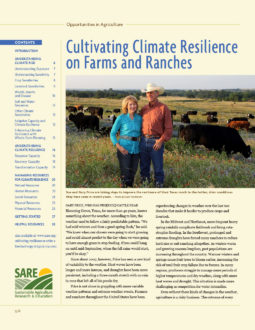Is climate change likely to affect weather patterns in your region? What does this mean for your farm or ranch? Understanding how the climate is already affecting the weather in your region, or is likely to affect it, gives you some of the information you need to estimate the climate risk to your operation. Exposure describes the type and intensity of climate effects already occurring in a specific location or that are likely to occur in the future. These effects might include more weather variability, more persistent or extreme drought, higher nighttime temperatures or more rainfalls that lead to flooding, for example. As the frequency and intensity of local climate exposures increase, so does the vulnerability of your farm or ranch.
Paul Muller co-owns and operates Full Belly Farm, a 400-acre diversified organic farm growing fruits, vegetables, grains and livestock in the Capay Valley of Northern California. Although water conservation has always been a management priority, climate challenges such as heavy rainfalls that happen more frequently, longer dry periods and continuing drought have prompted him to emphasize sustainable water management. “The last couple of years we have had the driest Januarys and Februarys on record,” Muller said in 2013. “That’s the time of year we normally get the moisture that goes deep in the ground, the moisture that serves as the reservoir for our crops that come in the spring. They get their roots down deep and draw on that water. The last couple of years, it just hasn’t been there.”
Dan Shepherd cannot say he has noticed any clear trends in changing weather patterns in the 40 years he has been farming, but the last decade or so has included several unusually extreme weather-related events on his farm. He manages 4,000 acres of commodity crops, including 300 acres of pecans on fertile floodplain soils along the east fork of the Chariton River near Clifton, Mo. Recent weather challenges include total crop loss from a late frost for the first time in 2007; flooding from the first levee breach in July 2008, which happened again in 2013; and three dry summers in a row starting in 2011.
The U.S. climate record shows that over the last century, average temperatures have increased, nights and winters have grown warmer, the growing season has lengthened, precipitation patterns have grown more variable, and there has been an increased frequency and intensity of extreme weather events. These changes are not consistent across the country but have occurred in regional patterns. Since these weather-related challenges are expected to continue to increase in frequency and intensity through this century, they are a new source of additional uncertainty to agricultural risk management. (See Table 1.)
